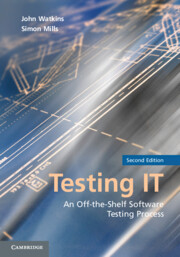Book contents
- Frontmatter
- Contents
- Foreword to the Second Edition by Geoff Thompson
- Foreword to the First Edition by Maurice Rosenburgh
- Acknowledgments
- 1 Introduction
- PART 1 THE TRADITIONAL TESTING PROCESS
- 2 An Overview of Testing
- 3 Testing Techniques
- 4 The Management and Planning of Testing
- 5 Unit Testing
- 6 Integration Testing
- 7 System Testing
- 8 Systems Integration Testing
- 9 User Acceptance Testing
- 10 Operations Acceptance Testing
- 11 Regression Testing
- 12 Improving the Testing Process
- 13 Introduction, Adoption, and Maintenance of the Testing Process
- 14 Agile Testing
- PART 2 THE TESTING PROCESS IN THE REAL WORLD: ILLUSTRATIVE CASE STUDIES
- PART 3 THE APPENDICES
- References
- Glossary
- Index
13 - Introduction, Adoption, and Maintenance of the Testing Process
Published online by Cambridge University Press: 03 May 2011
- Frontmatter
- Contents
- Foreword to the Second Edition by Geoff Thompson
- Foreword to the First Edition by Maurice Rosenburgh
- Acknowledgments
- 1 Introduction
- PART 1 THE TRADITIONAL TESTING PROCESS
- 2 An Overview of Testing
- 3 Testing Techniques
- 4 The Management and Planning of Testing
- 5 Unit Testing
- 6 Integration Testing
- 7 System Testing
- 8 Systems Integration Testing
- 9 User Acceptance Testing
- 10 Operations Acceptance Testing
- 11 Regression Testing
- 12 Improving the Testing Process
- 13 Introduction, Adoption, and Maintenance of the Testing Process
- 14 Agile Testing
- PART 2 THE TESTING PROCESS IN THE REAL WORLD: ILLUSTRATIVE CASE STUDIES
- PART 3 THE APPENDICES
- References
- Glossary
- Index
Summary
“Learn to Test, Test to Learn,” motto of the Empire Test Pilot School.
Introduction
Even the very best software testing process is nothing without the acceptance and consistent use by a community of testers within an organization. Technical issues aside, the introduction and adoption of a testing process is likely to be the most difficult step in providing a formal, rigorous, and reusable process within an organization.
This chapter examines the issues involved in introducing a testing process into an organization, and the management of its successful adoption and use. This chapter also addresses the issues associated with the subsequent maintenance and update of the testing process, and its ongoing evolution and enhancement.
The chapter concludes by providing process adoption guidance for those test practitioners who may be under pressure to deliver immediate quality improvements, but who may not have the luxury of sufficient time, resources, or budget.
Introduction and Adoption of a Testing Process
Overview
This section discusses the need to first establish that there is a requirement for a formal testing process within an organization, and where this is the case, goes on to discuss the need to develop a strategy for the introduction and adoption of the process.
- Type
- Chapter
- Information
- Testing ITAn Off-the-Shelf Software Testing Process, pp. 109 - 116Publisher: Cambridge University PressPrint publication year: 2010



